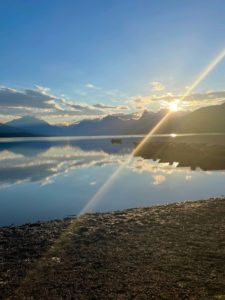 “More Fire, Less Ice” was Daniel Lombardi’s summary of the effects of climate change in Glacier. Daniel is a Communications Specialist for Glacier National Park whom we met with to discuss climate change in the park. Between 1966 and 2015, the last summer the USGS was able to effectively map the glaciers, every single named glacier had gotten smaller. Around 1850 there were around 80 glaciers in the area, and as of 2015, only 26 were still large enough to be considered glaciers. The number of wildfires in the west has doubled since the 1980s, but the frequency is even higher in Glacier. The fires have also become much more unpredictable and powerful as climate issues intensify.
“More Fire, Less Ice” was Daniel Lombardi’s summary of the effects of climate change in Glacier. Daniel is a Communications Specialist for Glacier National Park whom we met with to discuss climate change in the park. Between 1966 and 2015, the last summer the USGS was able to effectively map the glaciers, every single named glacier had gotten smaller. Around 1850 there were around 80 glaciers in the area, and as of 2015, only 26 were still large enough to be considered glaciers. The number of wildfires in the west has doubled since the 1980s, but the frequency is even higher in Glacier. The fires have also become much more unpredictable and powerful as climate issues intensify.
In 2018, a bolt of lightning struck a tree on a hill above Lake McDonald, which started a fire. Initially, park service and guests were not overly concerned; the fire was on top of a hill in a burn scar, the previous burn being in 2003, on a day with minimal wind. During the middle of the night, the wind picked up and brought the fire down to the lake side, burning all trees, shrubs, and family cabins along the way.
During my first time ever seeing Glacier National Park, I did not encounter a charred and melting landscape, but instead saw snow-peaked mountains and thriving forests. I was able to watch the sunrise over Lake McDonald and swim in its freezing waters. We rode the Going-to-the-Sun Road without cars, then get snow thrown at us by Dave near the top. I was able to have an amazing experience in this national park, while only seeing the impacts of climate change in a few places.
Although we were not able to see the damage done to the glaciers first-hand, we could see the scar that the 2018 fire left on the landscape. On the far side of Lake McDonald, we could see a rolling hillside of scorched trees poking above the short brush that has begun to grow below. The trees near a stream seemed to be left alive, leaving a fragment of the ecosystem intact, while the rest began its ecological succession.
Glacier National Park is home to some of the oldest trees I have ever seen in my life. The Western Red Cedar can grow up to 230 feet tall and live for over 500 years, and holds deep importance to some of the native tribes in the area. Glacier is home to many of these trees, but they are threatened with every passing fire. They have accumulated and sequestered an immense amount of carbon, which could all be released back into the air, rather than into the soil, with a large enough fire.
The consequences of these fires stretch far beyond the borders of Glacier. Last summer was the first summer I ever received a smoke air quality warning back home in Massachusetts. The larger and more frequent fires bring many health issues, now on a much larger scale than before. We were able to meet with Jeff Mow, former Superintendent of Glacier National Park, who believes that the largest impact on the park is the wildfire smoke. Higher amounts of fire smoke from in the park or anywhere on the west coast could make biking the Going-to-the-Sun Road dangerous and increase long term health implications.
Climate impacts not only affect the health of Glacier National Park and its ecosystems, but also the health of visitors and community members. I am so lucky to have been able to experience the natural beauty of this park, but I fear that climate change may prevent future generations from enjoying the same experience.